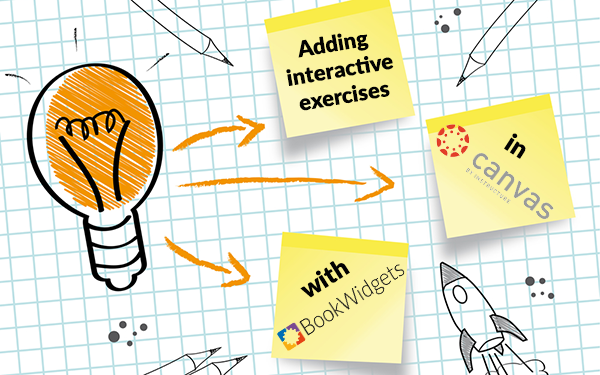Creating interactive exercises and automatically graded tests right inside Canvas
 Lucie Renard —
Lucie Renard —
Everything is connected to each other. That’s just how the world works today. So why not create an easy way for teachers to manage their classroom and assign interactive exercises and automatically graded tests?
After Google Classroom and Moodle, Canvas is now one of the learning management systems that allows you to connect with BookWidgets. Connect, and create: one platform, one digital classroom.
Before I dive into the details: what is Canvas, and what is BookWidgets? (If you already know, click here to skip to learning how to put your widgets in Canvas)
Canvas and BookWidgets
Canvas
Adaptable, reliable, customizable, easy to use, mobile and time-saving, Canvas is designed to get out of your way and to let you do your thing. What does that mean? Canvas ensures you that you won’t be spending time on finding out how the platform works and struggling with the technology. Every last feature and last interface is crafted to save you time and effort and to make teaching and learning easier.
Besides the basic features like sharing assignments, grading, annotation tools, notifications, feedback options, etc. Canvas also has a graphic analytics reporting engine. Analytics allow teachers to measure effectiveness of content, view learning outcomes, and intervene when students need extra help. Canvas is mostly used in middle and high school as well as colleges and universities.
Canvas has built a whole app center to make it easier for institutions and instructors to experiment and adapt new technologies into their courses. Browse through loads of LTI apps and install them in a single click. No IT support necessary. And that’s exactly what this BookWidgets integration with Canvas is all about.
BookWidgets
Canvas clears the path for other apps to build a complete digital teaching environment. With BookWidgets' new LMS integration, you can add more than 40 interactive exercises and create automatically graded tests, quizzes and assignments, right from within Canvas.
BookWidgets provides strong templates of all kinds of interactive exercises, you just have to add your own content.
Choose between more than 40 different widgets or “apps” to engage your students. Make your own adapted crossword riddles, jigsaw puzzles, web quests, quizzes, timelines and much more. Bonus: it does the grading for you.
BookWidgets can be used to engage students as well for differentiation, grading, flipped learning, gamification and microlearning.
How to create BookWidgets exercises in Canvas
Using a BookWidgets exercise in Canvas takes 4 simple steps: Two for the teacher, and two for the students. I’ll show you the short process from creating and sharing, to submitting, to grading and to receiving grades. Let’s take a look!
To get a more detailed explanation, take a look at the tutorial.
1. Adding a BookWidgets exercise to a course in Canvas (Teacher)
 If you want to create a widget, an exercise or an assignment with BookWidgets in Canvas, you go to the right course in which you want to assign an exercise.
If you want to create a widget, an exercise or an assignment with BookWidgets in Canvas, you go to the right course in which you want to assign an exercise.
- Go to “Assignments” and add a new one.
- Enter a title, a message to your students and scroll down to Submission type.
- Choose for “external tool” and click on “find”.
- Click on BookWidgets and create a new widget or choose one you’ve already made. When you’re ready, click on “Done” in the upper right corner.
- Now click on “Select”.
- Save your exercise and Publish it for your students.

2. Completing a BookWidgets exercise (Student)
 When students are logged in, they go to the right course. There, they’ll find a BookWidgets exercise as an assignment. They click on it to open the exercise.
When students are logged in, they go to the right course. There, they’ll find a BookWidgets exercise as an assignment. They click on it to open the exercise.
- Students go to “Assignments” and click on the BookWidgets assignment.
- They make the widget or exercise and click on “Submit” when done.

3. Giving feedback and returning student work (Teacher)
 In this step, you’re reviewing your students' (automatically graded) work. You get the chance to give feedback and
to change grades if necessary.
In this step, you’re reviewing your students' (automatically graded) work. You get the chance to give feedback and
to change grades if necessary.
- Go to the correct course and click on “BookWidgets results”.
- Click on the BookWidgets assignment students submitted earlier. You’ll see a global overview concerning all your students' answers.
- Click on the name of a student to see their submitted work.
- Grade and give feedback, using the pen button in the middle of the page on top.
- Return the work to the students.
- Go to “Grades” and you’ll see that they are automatically added to Canvas.

4. Receiving the grades (Student)
 Of course, students want to know if what they answered was correct or not. Here, students find out where they can see their grades, teacher feedback and answers.
Of course, students want to know if what they answered was correct or not. Here, students find out where they can see their grades, teacher feedback and answers.
- Students go the right course and click on “Grades”. Here, they see their grades for each assignment.
- They have to click on the assignment to open their work.
- Here’s they’ll find their answers to the questions and teacher feedback.

That’s it!
And that’s all there is to it! If you want to get more details, have a look at the tutorial below. Follow the steps carefully and you’re good to go. Questions? Contact us here.
How to enable BookWidgets in Canvas
If you would like to be able to use BookWidgets in Canvas, just ask your Canvas administrator (nicely) to follow this tutorial. In a few minutes, you’ll be ready to start creating.


